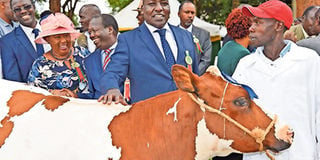Plan to make Kenya food secure unveiled

Agriculture CAS Andrew Tuimur at a past livestock show. He urged the private sector to partner with the government in implementing the food security plan, with focus on equipment suppliers, farmer associations, agro-dealers, warehouses and processors. FILE PHOTO | NMG
What you need to know:
- Besides being provided with the services, farmers will also be trained on using selected equipment.
- Kenya experiences between 20 to 30 per cent deficit in staple foods every year.
- Mr Eustace Muriuki of the Fertiliser Association of Kenya, faulted the government’s “structuring and mismanagement” of the fertiliser subsidy, saying it has caused price distortions.
The government has launched a plan to make Kenya food secure, hoping to halve poverty levels by 2025.
The plan includes increased mechanisation in agriculture from the current 25 to 40 per cent. The government in conjunction with devolved units also hopes to create an e-platform to register farmers.
Besides being provided with the services, farmers will also be trained on using selected equipment.
In a speech at the Future of Food conference in Nairobi last week, Agriculture CAS Andrew Tuimur urged the private sector to partner with the government in implementing the plan, with focus on equipment suppliers, farmer associations, agro-dealers, warehouses and processors.
“Development of SMES will contribute to an increase in average farmers’ incomes by 35 per cent (Sh465 to Sh625 per day), and 50 per cent increased contribution of agro-processing by Sh130 billion over five years,” Dr Tuimur said.
“Above all, agriculture should transform from a producer of raw materials to a consumer of goods and services at every stage of the value chain.”
Experts admit that high input prices, poor agricultural market systems, rapid population growth, huge post-harvest losses, unsuitable production systems and climate change pose the biggest challenge to sustainable food production.
Kenya experiences between 20 to 30 per cent deficit in staple foods every year. The maize deficit is 12 million bags, wheat is 595,000 tonnes, rice (425,570 tonnes), sugar (230,000), fish (314,900) and milk (334 million litres).
Those at the forum lauded the government’s subsidy programme though a majority opposed the idea of crop insurance for the country’s 2.3 million maize farmers, saying it is not feasible.
Two-thirds of those polled at the forum opposed the idea of the government distributing piglets, rabbits, day-old chicks or fingerlings, saying handouts are not a solution to problems facing agriculture.
Mr Eustace Muriuki of the Fertiliser Association of Kenya, faulted the government’s “structuring and mismanagement” of the fertiliser subsidy, saying it has caused price distortions.
He proposed the subsidisation of fertiliser imports at the port of entry, with set retail prices or provision of fertiliser to small scale farmers only.
He said the government should withdraw the subsidy and ensure timely purchase and high payment to farmers for cereals delivered to its stores.
The two-day conference recommended the creation of strong linkages between the market and production as well as the investment in a post-harvest management strategy.




